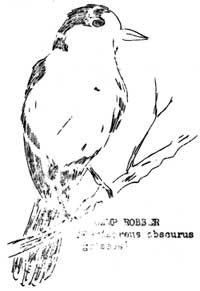
 | ||||||||
The cunning with which the Grey or Canada Jay, frequently called Camp Robber (Perisoreus obscurus griseus) hides its nest is classic among American natural-history annals and the finding of the nest of this bird is considered a rare feat of slouthing or a piece of exceptional good fortune. Not only is the bird a past master of the art of camouflage, but the fact that it rears its young at relatively high elevations and very early in the season before humans are abroad in numbers probably accounts for the extremely few nests which have been observed. 
Young Camp Robbers differ from their parents in the dark or slate colored plumage, showing none of the light grey feathers of the adults. The first of the 1934 generation was seen about Paradise Cabin Camp on June 23. On June 25, Mrs Tom Dodge, a visitor from Tacoma, was passing along the Nisqually Glacier Trail when she noticed a movement among the branches of a Mountain Hemlock (Tsuga mertensiana) about 20 feet from the ground. The disturbance proved to be caused by a Grey Jay feeding four nearly grown fledglings. The nest was built far out near the tip of the branch, and was thoroughly concealed by another branch over it. Lichens and twigs had been woven cleverly together to form the nest which blended perfectly with the foliage and lichens of the tree. The tree stands on the west slope of the canyon wall, near the crest of the ridge at an elevation of approximately 6000 feet. Natt Dodge, | ||||||
| <<< Previous | > Cover < | Next >>> |
vol12-8b.htm
01-Mar-2002